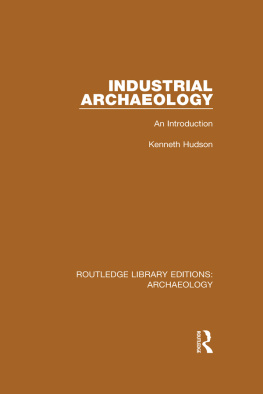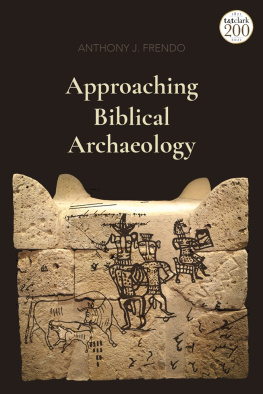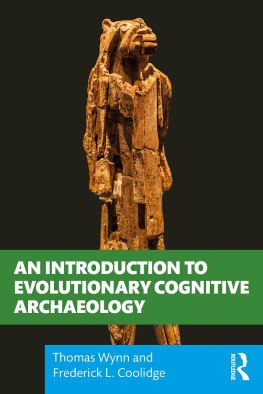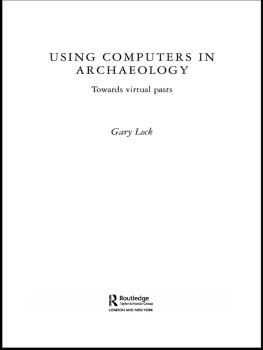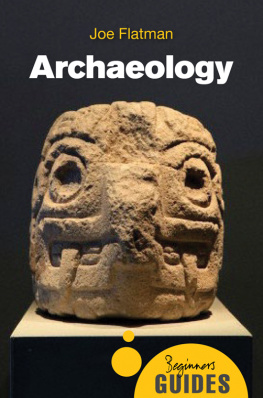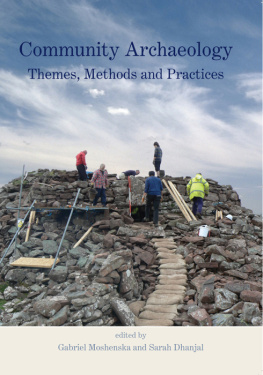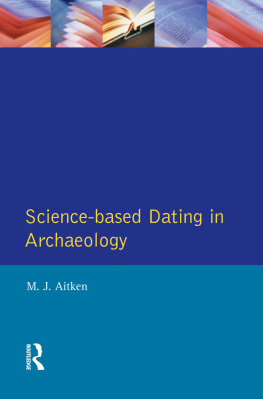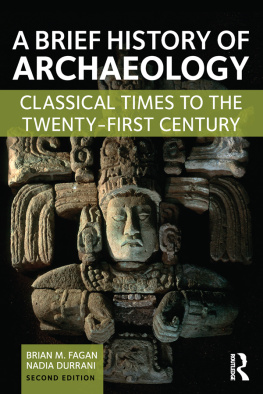ROUTLEDGE LIBRARY EDITIONS: ARCHAEOLOGY
Volume 35
INDUSTRIAL ARCHAEOLOGY
INDUSTRIAL ARCHAEOLOGY
An Introduction
KENNETH HUDSON

First published in 1963 by John Baker Publishers Ltd.
First published in 1965 by Methuen & Co. Ltd
This edition first published in 2015
by Routledge
2 Park Square, Milton Park, Abingdon, Oxon OX14 4RN
and by Routledge
711 Third Avenue, New York, NY 10017
Routledge is an imprint of the Taylor & Francis Group, an informa business
1963 Kenneth Hudson
All rights reserved. No part of this book may be reprinted or reproduced or utilised in any form or by any electronic, mechanical, or other means, now known or hereafter invented, including photocopying and recording, or in any information storage or retrieval system, without permission in writing from the publishers.
Trademark notice: Product or corporate names may be trademarks or registered trademarks, and are used only for identification and explanation without intent to infringe.
British Library Cataloguing in Publication Data
A catalogue record for this book is available from the British Library
ISBN: 978-1-138-79971-4 (Set)
eISBN: 978-1-315-75194-8 (Set)
ISBN: 978-1-138-81606-0 (Volume 35)
eISBN: 978-1-315-74638-8 (Volume 35)
Publishers Note
The publisher has gone to great lengths to ensure the quality of this book but points out that some imperfections from the original may be apparent.
Disclaimer
The publisher has made every effort to trace copyright holders and would welcome correspondence from those they have been unable to trace.
INDUSTRIAL ARCHAEOLOGY
An Introduction by
Kenneth Hudson
UNIVERSITY PAPERBACKS
____________________________
METHUEN : LONDON
First published 1963 by John Baker
Publishers Ltd.
Kenneth Hudson 1963
First published in this series 1965
For copyright reasons this book may not
be issued to the public on loan or otherwise
except in its original soft cover.
A cloth-bound library edition is also
available from John Backer Publisher Ltd.
University Paperbacks are published by
METHUEN & CO LTD
11 New Fetter Lane, London, E.C.4
Waterlow & Sons Limited, London Dunstable Hyde
CONTENTS
ILLUSTRATIONS
PLATES
PLANS IN TEXT
I SHOULD like to thank the many people who have dealt so patiently, helpfully and promptly with my innumerable queries, and particularly the following: Mr Frank Atkinson, of the Bowes Museum; Mr Maurice Barley, of the University of Nottingham; Mr N. Bertenshaw, of the City of Birmingham Museum; The Central Electricity Generating Board; The English Electric Co. Ltd.; The Esso Petroleum Co. Ltd.; Dr W. T. Freeman, of the University of Manchester; Mr J. Gourlay, of Stothert and Pitt, Ltd; Mr F. S. Willoughby Hancock; Mr H. J. Heck, County Planning Officer, Cornwall; Mr K. J. Hilton, Director of the Lower Swansea Valley Project; Mr Harold Jolliffe, of the Swindon Museum; Miss Antoinette Loughran, of the City of Liverpool Museums; Miss E. V. Marshall, of the Cement and Concrete Association; Mr R. I. Maxwell, County Planning Officer, Norfolk; Mr H. Milligan, of the Manchester Public Libraries; Mr J. P. M. Pannell, Engineer to the Southampton Harbour Board; Dr Iorwerth Peate, of the Welsh Folk Museum; Mr S. L. Pepper, of the National Coal Board; Mr R. W. Plenderleith, of the Royal Scottish Museum, Edinburgh; Mr K. Ponting; Mr D. W. Riley and Mr Robert Sherlock, of the County Planning Department, Stafford; Mr John H. Scholes, Curator of Historical Relics, British Transport Commission; Mr W. A. Seaby, of the Ulster Museum; Shell-Mex and B.P. Ltd.; Mr Maurice Taylor, County Planning Officer, Fife; Mr David St. John Thomas; Mr Rex Wailes; Mr Lionel Walrond, of the Stroud Museum; Mr Francis Wayne; Mr G. W. Williams, of Allied Ironfounders, Ltd.
Miss Beatrice de Cardi, Dr E. R. R. Green, Mr Michael Rix and Dr W. G. Hoskins have provided help and encouragement in a multitude of ways and with a most rare and welcome punctuality.
I am also grateful to the following for permission to reproduce copyright photographs: Aerofilms, Ltd. ().
The eighteen people who very kindly sent specialist contributions, some of considerable length, have been mentioned individually at the points where their material has been incorporated in the book.
Lastly, I should like to acknowledge my deepest gratitude to Miss Nadia Kempster, who has helped a great deal with the research and typed a most troublesome manuscript with the utmost efficiency and cheerfulness.
THIS book has had a curious history, which reflects Industrial Archaeologys struggle to get official recognition as a reputable study.
Five years ago, the Council for British Archaeology decided to sponsor a Handbook of Industrial Archaeology, in view of the urgent need to get important monuments recognised, listed, documented and, where possible, preserved. Dr Peter Eden, of the Royal Commission on Historical Monuments, undertook the Editorship of this Handbook and over a period of two years he collected a good deal of material from authoritative sources, although several important gaps remained.
In the summer of 1961, Dr Eden felt obliged, in view of the pressure of his other duties, to give up this work and I was eventually appointed his successor. At about the same time, the C.B.A. reached the end of its attempts to obtain any kind of grant or subsidy to enable it to publish the Handbook and since it had no funds of its own which could be devoted to this purpose, it looked as if the project would have to be abandoned.
Fortunately, however, a compromise solution presented itself. A publisher with a strong personal interest in archaeology, Mr John Baker, then of Phoenix House and now of John Baker Ltd., invited me to write a book on Industrial Archaeology, in which it would be possible to incorporate a great deal of the material accumulated for the C.B.A. Handbook. The present book is the result of Mr Bakers enlightened and public-spirited suggestion.
It does not set out to be an encyclopaedia of Industrial Archaeology. Its aim is the more modest one of attempting to draw attention to the surviving memorials of our industrial past and to help to create a public opinion which is sufficiently well informed to approve of money being spent on recording and preserving tangible evidence of some of the most remarkable achievements of a country which was, in its time, the leading industrial nation in the world.
THIS essay is a foray into the debatable borderland between history, technology and economics. Anyone who sets up as a middleman is likely to provoke the traditional mistrust of brokers and bodgers.
H. J. Habakkuk:
American and British Technology in the
Nineteenth Century.
THE TERM Industrial Archaeology is little more than ten years old. It was almost certainly invented early in the nineteen-fifties by Mr Donald Dudley, now Professor of Latin in the University of Birmingham and at that time Director of its Extra-Mural Department.
Mr Dudley did no more than throw this very useful phrase into conversation. Its first appearance in print appears to have occurred in the autumn of 1955, in an article written by Mr Michael Rix for The Amateur Historian. In this article Mr Rix implied, rather than stated, a definition of the new term. Great Britain, he said, as the birthplace of the Industrial Revolution is full of monuments left by this remarkable series of events. Any other country would have set up machinery for the scheduling and preservation of these memorials that symbolise the movement which is changing the face of the globe, but we are so oblivious of our national heritage that, apart from a few museum pieces, the majority of these landmarks are neglected or unwittingly destroyed.
Next page
